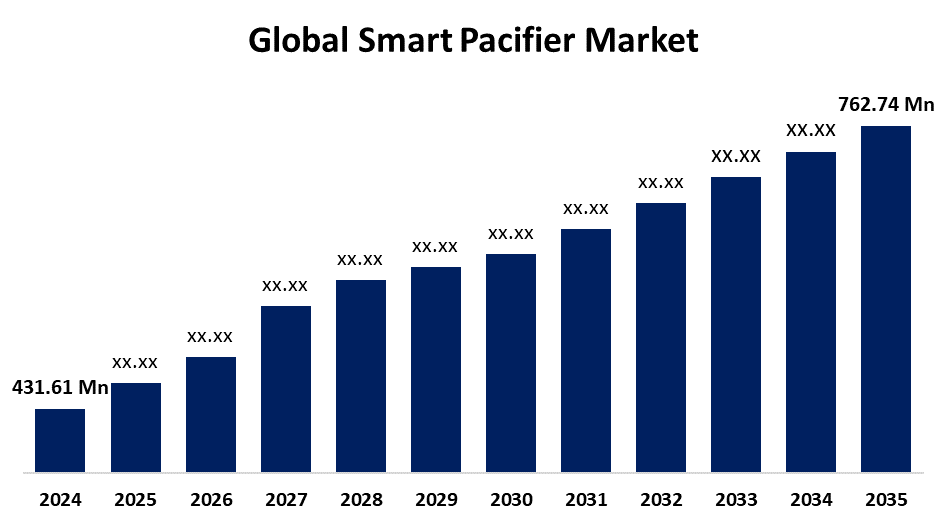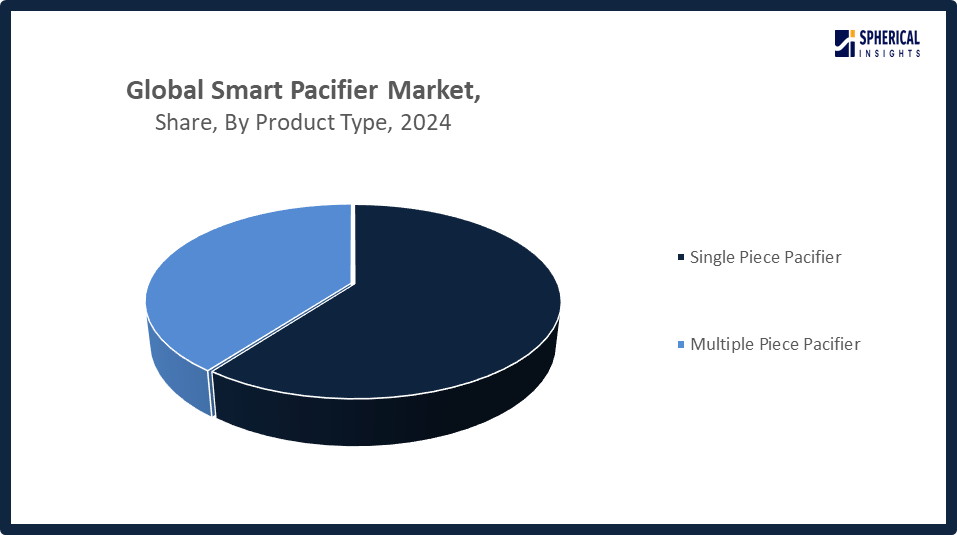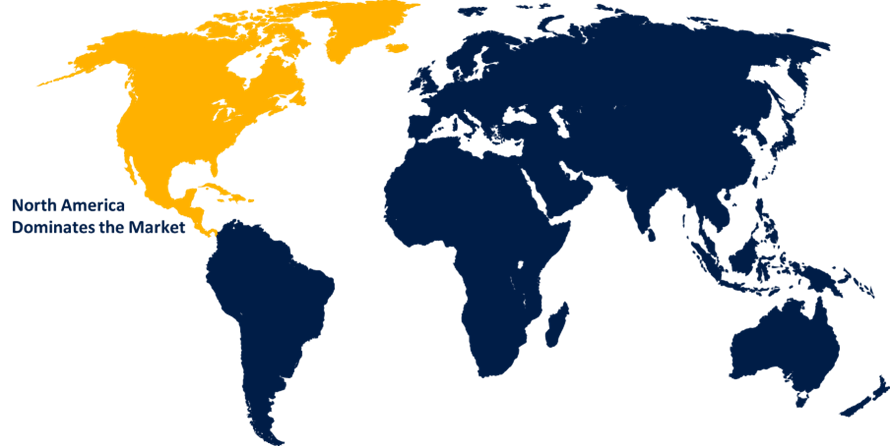Global Smart Pacifier Market Size, Share, and COVID-19 Impact Analysis, By Product Type (Single Piece Pacifier and Multiple Piece Pacifier), By Function (Electrolyte Monitoring and Temperature Monitoring), By Region (North America, Europe, Asia-Pacific, Latin America, Middle East, and Africa), Analysis and Forecast 2025 - 2035
Industry: HealthcareGlobal Smart Pacifier Market Insights Forecasts to 2035
- The Global Smart Pacifier Market Size Was Estimated at USD 431.61 Million in 2024
- The Market Size is Expected to Grow at a CAGR of around 5.31% from 2025 to 2035
- The Worldwide Smart Pacifier Market Size is Expected to Reach USD 762.74 Million by 2035
- Asia Pacific is expected to grow the fastest during the forecast period.

Get more details on this report -
According to a research report published by Spherical Insights and Consulting, The Global Smart Pacifier Market Size was worth around USD 431.61 Million in 2024, growing to USD 455.17 Million in 2025, and is predicted to grow to around USD 762.74 Million by 2035 with a compound annual growth rate (CAGR) of 5.31% from 2025 to 2035. The smart pacifier market is fueled by increasing parental interest in infant health, an increasing need for remote monitoring through connected devices, and the widening use of IoT technology in child care. Smart pacifiers provide real-time information on vital signs, which brings peace of mind and facilitates early detection of possible health problems, and this is attractive to tech-conscious parents.
Global Smart Pacifier Market Forecast and Revenue Outlook
- 2024 Market Size: USD 431.61 Million
- 2025 Market Size: USD 455.17 Million
- 2035 Projected Market Size: USD 762.74 Million
- CAGR (2025-2035): 5.31%
- North America: Largest market in 2024
- Asia Pacific: Fastest growing market
Market Overview
The smart pacifier market refers to the business of manufacturing and selling technologically innovative pacifiers that contain sensors and connectivity capabilities aimed at monitoring the health of infants. The smart pacifiers can monitor life signs such as body temperature, hydration rate, and feeding activities, and send real-time information to parents' phones via Wi-Fi or Bluetooth. Initially designed to enhance infant care and minimize the risk of uncontrolled illnesses, smart pacifiers provide a continuous, non-invasive monitoring option. Market expansion is influenced by growing awareness of infant health, increasing demand for intelligent parenting products, and rising usage of connected healthcare devices.
The future is offered in growing IoT-enabled healthcare, rising birth rates in developing markets, and rising disposable incomes. The market is dominated by BlueMaestro, Fridababy, Pixie Scientific, and other new health tech companies. Government support for digital health innovation and pediatric health technology funding also drives market growth further. Maternal and child health initiatives, especially in nations such as the U.S., India, and throughout the EU, are anticipated to drive adoption rates higher. While demand for real-time monitoring of infant health continues to increase, the market for smart pacifiers offers substantial potential both in developed and emerging economies.
Key Market Insights
- North America is expected to account for the largest share in the smart pacifier market during the forecast period.
- In terms of product type, the single piece pacifier segment is projected to lead the smart pacifier market throughout the forecast period
- In terms of function, the temperature monitoring segment captured the largest portion of the market
Smart Pacifier Market Trends
- Integration with smartphones and health apps enhances parental convenience and usability.
- Growing demand for real-time infant health monitoring is fueling smart pacifier adoption.
- Healthcare institutions are exploring smart pacifiers for use in neonatal intensive care units (NICUs).
- Miniaturization of sensors is making smart pacifiers safer and more comfortable for infants.
- Rising awareness of non-invasive baby health tools is boosting market visibility.
Report Coverage
This research report categorizes the smart pacifier market based on various segments and regions, forecasts revenue growth, and analyzes trends in each submarket. The report analyzes the key growth drivers, opportunities, and challenges influencing the smart pacifier market. Recent market developments and competitive strategies, such as expansion, type launch, development, partnership, merger, and acquisition, have been included to draw the competitive landscape in the market. The report strategically identifies and profiles the key market players and analyzes their core competencies in each sub-segment of the smart pacifier market.
Global Smart Pacifier Market Report Coverage
| Report Coverage | Details |
|---|---|
| Base Year: | 2024 |
| Market Size in 2024: | USD 431.61 Million |
| Forecast Period: | 2025-2035 |
| Forecast Period CAGR 2025-2035 : | 5.31% |
| 2035 Value Projection: | USD 455.17 Million |
| Historical Data for: | 2020-2023 |
| No. of Pages: | 240 |
| Tables, Charts & Figures: | 121 |
| Segments covered: | By Product Type, By Function, By Region |
| Companies covered:: | Koninklijke Philips N.V., Newell Brands Inc., Pigeon Corporation, MAM Babyartikel Gmbh, Angelcare USA LLC, Mayborn Group, Baby Shusher LLC., Natursutten ApS, Handi Craft Company, The Natural Baby Company LLC, Others |
| Pitfalls & Challenges: | Covid 19 Impact Challenges, Future, Growth and Analysis |
Get more details on this report -
Driving factors
The key drivers for the smart pacifier market include increasing infant health issues, the adoption of smart healthcare, technological innovation, parental awareness, and growing pediatric use, all of which fuel market expansion. Increasing infant health issues compel parents to look for effective tools for early disease detection and optimal care. Smart healthcare adoption promotes the use of interconnected devices such as smart pacemakers for real-time tracking. Advances in technology have enabled the development of miniaturized, safe sensors for babies. Parental awareness fuels demand for preventative infant health solutions. Finally, more pediatric uses bring smart pacifier utilization into hospitals and clinics, allowing professional care and eliminating invasive monitoring techniques.
Restraining Factor
Restraints to the smart pacifier market are high expenses, privacy and security issues, consumer distrust, and complicated regulatory approval processes. Expensive smart pacifiers are unaffordable for most consumers, particularly in developing countries. Privacy and security issues stem from data storage and communication. Consumer distrust impacts confidence in accuracy and need. Complicated regulatory approvals slow market entry and add compliance burdens to manufacturers.
Market Segmentation
The global smart pacifier market is divided into product type and function.
Global Smart Pacifier Market, By Product Type:
Why did the single piece pacifier segment dominate the market in 2024?
The single piece pacifier segment led the market with its improved safety, cleanability, and longevity. Parents favored its sanitary design, preventing choking and bacterial accumulation, making it a safe option for babies and caregivers alike.

Get more details on this report -
The multiple piece pacifier segment in the smart pacifier market is expected to grow at the fastest CAGR over the forecast period. The multi piece pacifier segment is anticipated to develop at the highest rate based on customizable designs, improved comfort, simple replacement of the parts, and growing demand for personalized, hygienic, and long-lasting smart pacifier products.
Global Smart Pacifier Market, By Function:
What makes the temperature monitoring segment dominate the smart pacifier market in 2024?
The temperature monitoring segment led the smart pacifier market due to it provide real-time health monitoring, which gives parents immediate fever notifications and reassurance. Its ease of use, precision, and connectivity with mobile apps for effortless tracking made it a mandatory baby care and protection tool.
The electrolyte monitoring segment in the smart pacifier market is expected to grow at the fastest CAGR over the forecast period. The electrolyte monitoring market is forecasted to expand at the fastest rate with increased awareness of infant hydration, increased need for real-time health data, and sensor technology development for precise, non-invasive tracking of electrolyte levels.
Regional Segment Analysis of the Global Smart Pacifier Market
- North America (U.S., Canada, Mexico)
- Europe (Germany, France, U.K., Italy, Spain, Rest of Europe)
- Asia-Pacific (China, Japan, India, Rest of APAC)
- South America (Brazil and the Rest of South America)
- The Middle East and Africa (UAE, South Africa, Rest of MEA)
North America Smart Pacifier Market Trends

Get more details on this report -
What factors contribute to North America leading the global smart pacifier market during the forecast period?
North America dominates the worldwide smart pacifier market throughout the forecast period due to increased parental awareness, robust healthcare infrastructure, and early embracement of sophisticated baby care technology. Rising demand for real-time infant health monitoring, rising disposable incomes, and the availability of prominent industry players further fuel growth. The country also has a supportive regulatory environment and extensive availability of smart healthcare products, hence becoming a center of innovation and consumer confidence in smart baby care solutions.
How are technological innovations impacting the U.S. smart pacifier market?
The U.S. smart pacifier market is being driven by technological advancements that bring real-time health monitoring, improved safety, and mobile app integration, building parental confidence and the demand for advanced baby care solutions.
Asia Pacific Smart Pacifier Market Trends
What contributes to the rapid growth of the smart pacifier market in the Asia Pacific compared to other regions?
The growth in the smart pacifier market in the Asia Pacific is being led by rising birth rates, growing parental concerns about infant health, and demand for advanced baby care products. Urbanization and increasing disposable incomes are leading to a willingness among consumers to spend money on smart healthcare products. Widening e-commerce platforms are bringing these products within reach, even in rural regions. Moreover, regional governments are investing in digital health innovations, and regional producers are selling affordable, tech-enabled pacifiers. All these factors combined make the Asia Pacific the world's rapidly growing market.
What key trends are driving the smart pacifier market in India?
Dominant trends influencing the Indian smart pacifier market are growing parental awareness, rising demand for real-time tracking of infant health, expanding e-commerce reach, and adoption of technologies such as AI and sensors in baby products to enhance safety and convenience.
What technological and economic factors are shaping smart pacifier adoption trends in China?
In China, the adoption of smart pacifiers is fueled by technological developments in sensors, AI, increased healthcare investments, rising middle-class income, and heightened demand for intelligent, health-oriented infant care solutions.
Why is the smart pacifier market evolving in Japan?
The Japanese market for smart pacifiers is developing due to an aging population is concerned with the health of infants, has high technology adoption, enhanced awareness of healthcare, and a need for safe, data-led parenting solutions.
Europe Smart Pacifier Market Trends
What factors are driving growth in the European smart pacifier market?
Europe's smart pacifier market growth is supported by increasing awareness about baby health, robust healthcare infrastructure, and rising demand for innovative baby care items. Supportive government policies, rising wearable health tech adoption, and high levels of parental concern regarding safety and sanitation are further driving market growth across nations such as Germany, France, and the U.K.
What consumer preferences are shaping the smart pacifier market trends in the U.K.?
In the U.K., consumer demand for safety, hygiene, real-time health tracking, and technology-based baby products is driving smart pacifier trends, with parents looking for convenience, reliability, and improved infant care solutions.
Competitive Analysis:
The report offers the appropriate analysis of the key organizations/companies involved within the global smart pacifier market, along with a comparative evaluation primarily based on their type of offering, business overviews, geographic presence, enterprise strategies, segment market share, and SWOT analysis. The report also provides an elaborate analysis focusing on the current news and developments of the companies, which includes type development, innovations, joint ventures, partnerships, mergers & acquisitions, strategic alliances, and others. This allows for the evaluation of the overall competition within the market.
Worldwide Top Key Players In The Smart Pacifier Market Include
- Koninklijke Philips N.V.
- Newell Brands Inc.
- Pigeon Corporation
- MAM Babyartikel Gmbh
- Angelcare USA LLC
- Mayborn Group
- Baby Shusher LLC.
- Natursutten ApS
- Handi Craft Company
- The Natural Baby Company LLC
- Others
Key Target Audience
- Market Players
- Investors
- End-users
- Government Authorities
- Consulting And Research Firm
- Venture capitalists
- Value-Added Resellers (VARs)
Recent development
- In September 2025, NUK partnered with educator Ms. Rachel to launch Sippy Cups, aiding toddlers’ transition from bottle to cup, reinforcing NUK’s 70-year commitment to quality baby care and supporting natural child development.
- In August 2025, Pigeon India Pvt. Ltd launched the Paladai Baby Feeder, inspired by traditional Indian paladai cups, designed to support specialist care for newborns, including preterm and low birthweight babies, and their families.
- In August 2025, Philips launched the Philips Avent Hands-free Breast Pump in India, featuring Masaba Gupta in the GiftOfFreedom campaign, promoting breastfeeding support and flexibility during World Breastfeeding Week.
- In June 2025, Pigeon Singapore launched the MiniLight Pacifier Sustainable Collection in collaboration with The Animal Project, promoting inclusivity, sustainability, and showcasing the creativity of artists with special needs through thoughtfully designed pacifiers.
- In February 2024, WubbaNub launched the Baby Bullseye range, featuring Target’s Bull Terrier mascot. The 100% silicone pacifier plush is BPA, PVC, and phthalate-free, combining safety with cuddly design and machine washability.
Market Segment
This study forecasts revenue at the global, regional, and country levels from 2020 to 2035. Spherical Insights has segmented the smart pacifier market based on the following segments:
Global Smart Pacifier Market, By Product Type
- Single Piece Pacifier
- Multiple Piece Pacifier
Global Smart Pacifier Market, By Function
- Electrolyte Monitoring
- Temperature Monitoring
Global Smart Pacifier Market, By Regional Analysis
- North America
- US
- Canada
- Mexico
- Europe
- Germany
- UK
- France
- Italy
- Spain
- Russia
- Rest of Europe
- Asia Pacific
- China
- Japan
- India
- South Korea
- Australia
- Rest of Asia Pacific
- South America
- Brazil
- Argentina
- Rest of South America
- Middle East & Africa
- UAE
- Saudi Arabia
- Qatar
- South Africa
- Rest of the Middle East & Africa
Frequently Asked Questions (FAQ)
-
1. What is the CAGR of the smart pacifier market over the forecast period?The global smart pacifier market is projected to expand at a CAGR of 5.31% during the forecast period.
-
2. What is the market size of the smart pacifier market?The global smart pacifier market size is expected to grow from USD 431.61 million in 2024 to USD 762.74 million by 2035, at a CAGR 5.31% of during the forecast period 2025-2035.
-
3. What are the market trends in the smart pacifier market?Market trends include tech integration (AI/IoT), enhanced health monitoring, connectivity, personalized features, and a rise in sustainability and eco-friendly designs.
-
4. Which region holds the largest share of the smart pacifier market?North America is anticipated to hold the largest share of the smart pacifier market over the predicted timeframe.
-
5. Who are the top 10 companies operating in the global smart pacifier market?The major players operating in the smart pacifier market are Koninklijke Philips N.V., Newell Brands Inc., Pigeon Corporation, MAM Babyartikel GmbH, Angelcare USA LLC, Mayborn Group, Baby Shusher LLC, Natursutten ApS, Handi Craft Company, The Natural Baby Company LLC, and Others.
-
6. What factors are driving the growth of the smart pacifier market?Growth in the smart pacifier market is driven by increased parental demand for infant health monitoring devices, integration of IoT and sensor technology, the appeal of connected baby care products, and the ability of these devices to provide real-time data for safety and early detection of health issues.
-
7. What are the main challenges restricting wider adoption of the smart pacifier market?High costs, privacy concerns, limited awareness, and technical complexities are the main challenges restricting the wider adoption of smart pacifiers globally.
Need help to buy this report?